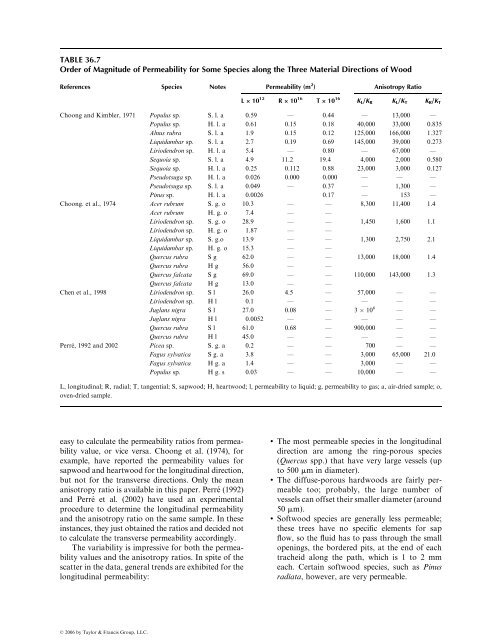36 Drying of Wood
36 Drying of Wood
36 Drying of Wood
- No tags were found...
You also want an ePaper? Increase the reach of your titles
YUMPU automatically turns print PDFs into web optimized ePapers that Google loves.
TABLE <strong>36</strong>.7Order <strong>of</strong> Magnitude <strong>of</strong> Permeability for Some Species along the Three Material Directions <strong>of</strong> <strong>Wood</strong>References Species Notes Permeability (m 2 ) Anisotropy RatioL · 10 12 R · 10 16 T · 10 16 K L /K R K L /K T K R /K TChoong and Kimbler, 1971 Populus sp. S. l. a 0.59 — 0.44 — 13,000 —Populus sp. H. l. a 0.61 0.15 0.18 40,000 33,000 0.835Alnus rubra S. l. a 1.9 0.15 0.12 125,000 166,000 1.327Liquidambar sp. S. l. a 2.7 0.19 0.69 145,000 39,000 0.273Liriodendron sp. H. l. a 5.4 — 0.80 — 67,000 —Sequoia sp. S. l. a 4.9 11.2 19.4 4,000 2,000 0.580Sequoia sp. H. l. a 0.25 0.112 0.88 23,000 3,000 0.127Pseudotsuga sp. H. l. a 0.026 0.000 0.000 — — —Pseudotsuga sp. S. l. a 0.049 — 0.37 — 1,300 —Pinus sp. H. l. a 0.0026 0.17 — 153 —Choong. et al., 1974 Acer rubrum S. g. o 10.3 — — 8,300 11,400 1.4Acer rubrum H. g. o 7.4 — —Liriodendron sp. S. g. o 28.9 — — 1,450 1,600 1.1Liriodendron sp. H. g. o 1.87 — —Liquidambar sp. S. g.o 13.9 — — 1,300 2,750 2.1Liquidambar sp. H. g. o 15.3 — —Quercus rubra S g 62.0 — — 13,000 18,000 1.4Quercus rubra H g 56.0 — —Quercus falcata S g 69.0 — — 110,000 143,000 1.3Quercus falcata H g 13.0 — —Chen et al., 1998 Liriodendron sp. S l 26.0 4.5 — 57,000 — —Liriodendron sp. H l 0.1 — — — — —Juglans nigra S l 27.0 0.08 — 3 10 6 — —Juglans nigra H l 0.0052 — — — — —Quercus rubra S l 61.0 0.68 — 900,000 — —Quercus rubra H l 45.0 — — — — —Perré, 1992 and 2002 Picea sp. S. g. a 0.2 — — 700 — —Fagus sylvatica S g. a 3.8 — — 3,000 65,000 21.0Fagus sylvatica H g. a 1.4 — — 3,000 — —Populus sp. H g. s 0.03 — — 10,000 — —L, longitudinal; R, radial; T, tangential; S, sapwood; H, heartwood; l, permeability to liquid; g, permeability to gas; a, air-dried sample; o,oven-dried sample.easy to calculate the permeability ratios from permeabilityvalue, or vice versa. Choong et al. (1974), forexample, have reported the permeability values forsapwood and heartwood for the longitudinal direction,but not for the transverse directions. Only the meananisotropy ratio is available in this paper. Perré (1992)and Perré et al. (2002) have used an experimentalprocedure to determine the longitudinal permeabilityand the anisotropy ratio on the same sample. In theseinstances, they just obtained the ratios and decided notto calculate the transverse permeability accordingly.The variability is impressive for both the permeabilityvalues and the anisotropy ratios. In spite <strong>of</strong> thescatter in the data, general trends are exhibited for thelongitudinal permeability:. The most permeable species in the longitudinaldirection are among the ring-porous species(Quercus spp.) that have very large vessels (upto 500 mm in diameter).. The diffuse-porous hardwoods are fairly permeabletoo; probably, the large number <strong>of</strong>vessels can <strong>of</strong>fset their smaller diameter (around50 mm).. S<strong>of</strong>twood species are generally less permeable;these trees have no specific elements for sapflow, so the fluid has to pass through the smallopenings, the bordered pits, at the end <strong>of</strong> eachtracheid along the path, which is 1 to 2 mmeach. Certain s<strong>of</strong>twood species, such as Pinusradiata, however, are very permeable.ß 2006 by Taylor & Francis Group, LLC.
















